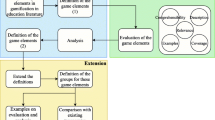Abstract
OPEN is an ontology-based programming framework for rapid prototyping, sharing, and personalization of context-aware applications. Unlike previous systems that provide programming support for single group of users, OPEN provides different programming support for users with diverse technical skills. According to the programming requirements of different users, several cooperation patterns are identified, and the mechanisms to facilitate resource sharing and reuse are built into the framework. Three corresponding programming modes are elaborated by showing how a context-aware game has been developed with the support of the OPEN framework, and the usability of our system is validated through an initial user study.








Similar content being viewed by others
References
Lieberman H, Paternò F, Wulf V (2008) End user development. Springer, Dordrecht
Salber D, Dey AK, Abowd GD (1999) The context toolkit: aiding the development of context-enabled applications. In: Proceedings of CHI’99, pp 434–441
Chen G, Kotz D (2002) Solar: an open platform for context-aware mobile applications. In: Proceedings of the 1st international conference on pervasive computing, pp 41–47
Chen H, Finin T, Joshi A, Perich F, Chakraborty D, Kagal L (2004) Intelligent agents meet the semantic web in smart spaces. IEEE Internet Comput 19(5):69–79
Wang XH, Zhang DQ, Dong JS, Chin CY, Hettiarachchi S (2004) Semantic space: an infrastructure for smart spaces. IEEE Pervasive Comput 3(3):32–39
Gu T, Pung HK, Zhang DQ (2005) A service-oriented middleware for building context-aware services. Elsevier J Network Comput Appl 28(1):1–18
Yu ZW, Zhang DQ, Zhou XS, Chin C, Yu ZY (2006) An OSGi-based infrastructure for context-aware multimedia services. IEEE Commun Mag 44(10):136–142
Guo B, Satake S, Imai M (2008) Home-explorer: ontology-based physical artifact search and hidden object detection system. Mobile Inf Syst 4(2):81–103
Dey AK, Sohn T, Streng S, Kodama J (2006) iCAP: interactive prototyping of context-aware applications. In: Proceedings of pervasive 2006, pp 254–271
Mattila J, Väätänen A (2006) UbiPlay: an interactive playground and visual programming tools for children. In: Proceedings of the conference on interaction design and children, pp 129–136
Montemayor J, Druin A, Chipman G, Farber A, Guha ML (2004) Tools for children to create physical interactive storyrooms. Comput Entertain 2(1):12
Blackwell AF, Hague R (2001) AutoHAN: an architecture for programming the home. In: Proceedings of the IEEE symposium on human-centric computing languages and environments, pp 150–157
Tang L, Yu ZW, Zhou XS, Wang HB, Becker C (2010) Supporting rapid design and evaluation of pervasive applications: challenges and solutions. Personal and ubiquitous computing
Gu T, Pung HK, Zhang DQ (2004) Toward an OSGi-based infrastructure for context-aware applications. IEEE Pervasive Comput 3(4):66–74
Guo B, Satake S, Imai M (2006) Sixth-sense: context reasoning for potential objects detection in smart sensor rich environment. In: Proceedings of the IEEE/WIC/ACM international conference on intelligent agent technology (IAT’06), Hong Kong
Nishida Y et al (2003) 3D ultrasonic tagging system for observing human activity. In: Proceedings of IEEE international conference on intelligent robots and systems, pp 785–701
Nakadai K, Tsujino H (2005) Towards new human-humanoid communication: listening during speaking by using ultrasonic directional speaker. In: Proceedings of robotics and automation, pp 1495–1500
Ishii K, Yamamoto Y, Imai M, Nakadai K (2007) A navigation system using ultrasonic directional speaker with rotating base. In: Proceedings of HCI07, pp 526–535
O’Connor MJ, Knublauch H, Tu SW (2005) Supporting rule system interoperability on the semantic web with SWRL. In: Proceedings of the 4th international semantic web conference
Author information
Authors and Affiliations
Corresponding author
Rights and permissions
About this article
Cite this article
Guo, B., Zhang, D. & Imai, M. Toward a cooperative programming framework for context-aware applications. Pers Ubiquit Comput 15, 221–233 (2011). https://doi.org/10.1007/s00779-010-0329-1
Received:
Accepted:
Published:
Issue Date:
DOI: https://doi.org/10.1007/s00779-010-0329-1




